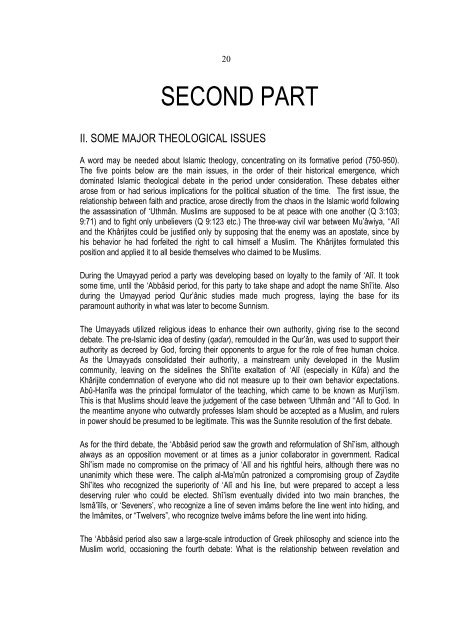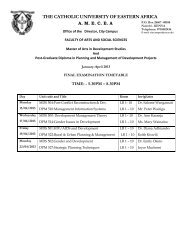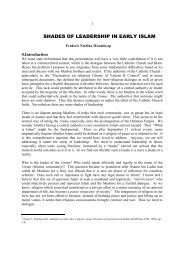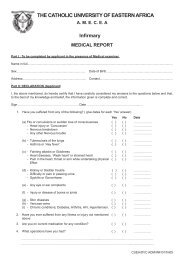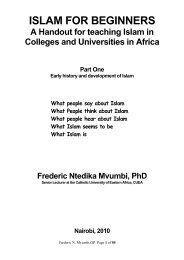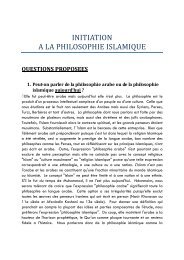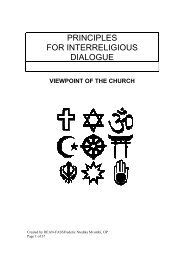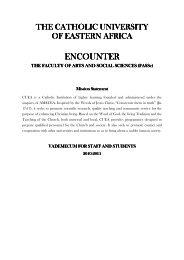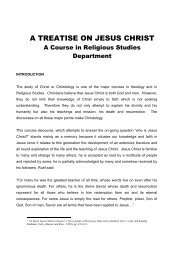INTRODUCTION TO ISLAMIC THEOLOGY.pdf - CUEA
INTRODUCTION TO ISLAMIC THEOLOGY.pdf - CUEA
INTRODUCTION TO ISLAMIC THEOLOGY.pdf - CUEA
Create successful ePaper yourself
Turn your PDF publications into a flip-book with our unique Google optimized e-Paper software.
20SECOND PARTII. SOME MAJOR THEOLOGICAL ISSUESA word may be needed about Islamic theology, concentrating on its formative period (750-950).The five points below are the main issues, in the order of their historical emergence, whichdominated Islamic theological debate in the period under consideration. These debates eitherarose from or had serious implications for the political situation of the time. The first issue, therelationship between faith and practice, arose directly from the chaos in the Islamic world followingthe assassination of ‘Uthmân. Muslims are supposed to be at peace with one another (Q 3:103;9:71) and to fight only unbelievers (Q 9:123 etc.) The three-way civil war between Mu’âwiya, ‘‘Alîand the Khârijites could be justified only by supposing that the enemy was an apostate, since byhis behavior he had forfeited the right to call himself a Muslim. The Khârijites formulated thisposition and applied it to all beside themselves who claimed to be Muslims.During the Umayyad period a party was developing based on loyalty to the family of ‘Alî. It tooksome time, until the ‘Abbâsid period, for this party to take shape and adopt the name Shî’ite. Alsoduring the Umayyad period Qur’ânic studies made much progress, laying the base for itsparamount authority in what was later to become Sunnism.The Umayyads utilized religious ideas to enhance their own authority, giving rise to the seconddebate. The pre-Islamic idea of destiny (qadar), remoulded in the Qur’ân, was used to support theirauthority as decreed by God, forcing their opponents to argue for the role of free human choice.As the Umayyads consolidated their authority, a mainstream unity developed in the Muslimcommunity, leaving on the sidelines the Shî’ite exaltation of ‘Alî (especially in Kûfa) and theKhârijite condemnation of everyone who did not measure up to their own behavior expectations.Abû-Hanîfa was the principal formulator of the teaching, which came to be known as Murji’ism.This is that Muslims should leave the judgement of the case between ‘Uthmân and ‘‘Alî to God. Inthe meantime anyone who outwardly professes Islam should be accepted as a Muslim, and rulersin power should be presumed to be legitimate. This was the Sunnite resolution of the first debate.As for the third debate, the ‘Abbâsid period saw the growth and reformulation of Shî’ism, althoughalways as an opposition movement or at times as a junior collaborator in government. RadicalShî’ism made no compromise on the primacy of ‘Alî and his rightful heirs, although there was nounanimity which these were. The caliph al-Ma’mûn patronized a compromising group of ZayditeShî’ites who recognized the superiority of ‘Alî and his line, but were prepared to accept a lessdeserving ruler who could be elected. Shî’ism eventually divided into two main branches, theIsmâ’îlîs, or ‘Seveners’, who recognize a line of seven imâms before the line went into hiding, andthe Imâmites, or “Twelvers”, who recognize twelve imâms before the line went into hiding.The ‘Abbâsid period also saw a large-scale introduction of Greek philosophy and science into theMuslim world, occasioning the fourth debate: What is the relationship between revelation and


